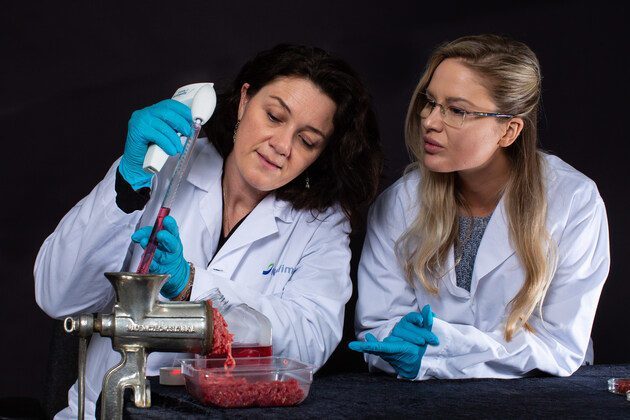One cell (+ residual raw material) can become several thousand kilograms of meat

The starting point is a cell sample from a live cow. A bioreactor, a serum and a few weeks later, the result can be thousands of kilograms of cultivated meat.
Science fiction? Not at all. Nofima scientist Sissel B. Rønning believes this is how future meat production will take place.
Therefore, she is both pleased and proud that Nofima, as the first institute in Norway with public funding, dared to get involved in a field of research that is still quite controversial.
“Food production accounts for many of the greenhouse gas challenges around the world. And meat production is seen as being one of the worst causes. Therefore, the meat industry is looking for new and more environmentally friendly ways to produce meat and animal proteins. Cultivated meat, completely independent of animal production, is the environmentally friendly production of protein for a growing world population. Therefore, it is very important that the academic communities at Nofima, and also Norway as a food nation, are at the forefront of this development”, says Sissel B. Rønning.
Groundbreaking
In the GrowPro research programme, the goal was to develop cutting-edge technology regarding the sustainable production of muscle proteins for food. In more simple terms; the cultivation of meat.
The scientists wanted to cultivate live muscle cells from cattle on a large scale using bioreactors, utilise by-products from the food industry during this process, and also map the functional and nutritional properties of the proteins found in foods.
After four years of research, the goal has largely been achieved. Nofima and Norway are placed on the map as one of the academic communities that are able to cultivate meat, and are at the forefront when it comes to this type of process. Sissel Rønning and her colleagues have managed to cultivate small pieces of meat, and the knowledge about residual raw materials as food for the meat cells has improved significantly and pointed to several possibilities.
“The interesting thing about cell cultivation, which is what the cultivation of meat actually is, is the growth factor. The serum that becomes food for the cells. In current production, it is common to use a serum made from the components of calf fetuses. This has caused a lot of people to be critical of this type of protein cultivation”, says Sissel Rønning.
However, she sees the benefits of cultivated meat: The cultivation of meat can be done anywhere, the pressure on arable land decreases, surplus materials – such as residual raw materials and surplus heat from other industries – can be utilised, Norwegian industry is developed in yet another new direction, we get an increased degree of self-sufficiency regarding food in Norway, and we do not have to kill animals to produce the necessary protein in the form of meat.
“It is really important to be at the forefront. In Norway, we have both the expertise and the money needed to develop new technical solutions for food production”, says Sissel Rønning.
Sustainable approach
At Nofima, a more sustainable approach to the cultivation of meat cells has been important; to make the serum based on by-products and residual raw materials rather than calf fetuses. Egg white is a possibility. Blood from slaughterhouses is another. Can anything else from the slaughter industry be used?
“What we have done so far is form the basis for further research by acquiring many new techniques that are now going to be tested further. Doctoral research fellow Christel Andreassen is well underway in testing components in the cell medium. She has produced several different types of by-product hydrolysates from the industry, including offcut bones from chicken, backbones from cod, egg white and eggshell membrane, and she will probably be the first in Norway to write a PhD on this technology. Christel has already been headhunted to the prestigious Boston University, so we are very proud of what she has achieved, and that through our ties to her, we have access to strong, global academic environments”, says Sissel Rønning.
Great attention
“Some countries already claim that they are able to make approximately 500 kilograms of meat per week, with a production time of three weeks. Why then should Nofima spend more time and resources on this?”
“There is a huge gap between available academic information and what international industry is saying about the progress of cultivated meat. There are no published scientific articles documenting how far the development has come. There are also some pilot facilities, but to my knowledge no large production facilities for cultivated meat have been built anywhere in the world. Therefore, I am a little sceptical when it is claimed that meat is cultivated on a large scale”, says Sissel Beate Rønning.
In any case – she thinks that this is the most important thing:
“Just because others are doing it, it doesn’t mean we shouldn’t. On the contrary; from a future perspective, it is important that we do not become dependent on other nations, which may be using methods we do not want to be associated with.”
“As Norway’s foremost exponent of cultivated meat; do you face a lot of criticism?”
“I mostly meet curiosity. I get a lot of questions about how the cultivation of meat takes place. GrowPro is not a big project in a Nofima context, but it is without comparison the project I have received the most attention for. It is quite clear that there is interest in this type of food production.”
Rigid, formal processes
“It is claimed that there are some ethical and regulatory dilemmas related to the cultivation of meat. Are you aware of any?”
“We are talking about sustainability, environmentally, economically and socially. There are many employees associated with the conventional production of meat – both in agriculture and industry. Cultivating meat will not be socially sustainable if it leads to job losses. And then there is the point about the growth factor in the serum that ‘feeds’ the cells. As for regulatory dilemmas, there are not that many, but there are some rigid, formal processes associated with this new way of producing proteins. According to European Food Safety Authority (EFSA) regulations, documentation must be provided stating that it is safe”, says Sissel Rønning, adding that restaurants in Singapore are already allowed to serve cultivated meat.
In 2013, for the first time, one could taste a real burger that was cultivated in a laboratory by Professor Mark Post at Maastricht University. This burger, which cost NOK 2.8 million to produce, showed that it is possible to cultivate meat in a laboratory.
The challenge now is to achieve large-scale production that is cheap, environmentally friendly and efficient, resulting in an end product that can be used directly for food.
“Is a cultivated Norwegian steak a long way off?”
“Yes, it is! But that is not our job to worry about. As a research institute, we must produce the knowledge needed for the industry to develop the process.”
She hopes to further build on this knowledge through a larger, interdisciplinary project that involves regulations, sensory aspects, technology and ethical dilemmas. The application for funding is being processed in the EU.
“In this project, we also have other research communities and several major industry actors as partners. Nevertheless, we will continue our research through the strategic programmes at Nofima, which initially run until 2024”, says Sissel Rønning.
Facts
- The research mentioned in this article has been done in the project GrowPro.
- The research is financed by the Research Council of Norway.
Contact persons
Research areas
Food from new sources
Topics
Labgrown meat

